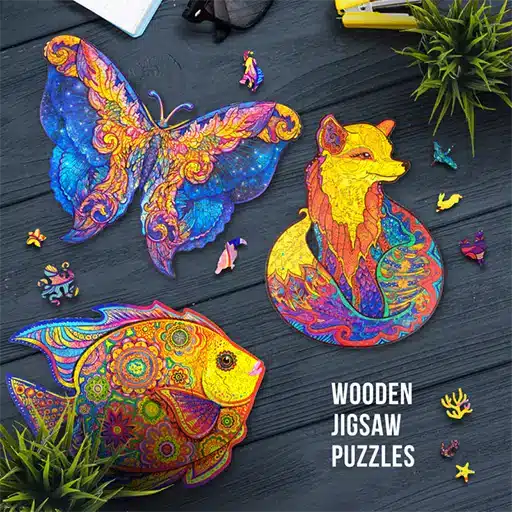Table of Contents
Playing Sudoku
The basic rules of sudoku are simple so anyone can learn them. Sudoku is a logic puzzle game in which you fill a grid of (typically) nine rows and nine columns with numbers ranging from 1 to 9. The grid is broken further into nine smaller grids of three rows and three columns known as boxes. The goal of the game is to fill in the blank cells with numbers while ensuring that every number from 1 to 9 appears only once in each row, column, and box.
FREE Download – Sudoku for Kids
Below, you can download a PDF with some puzzles specifically designed for kids. My Sudoku for Kids puzzles are smaller (4×4 grids) and use either numbers or letters.
The download is essentially a starter pack. The idea being that they are simple enough that parents can create more grids more the kids to solve.
However, I would like to know if people would be interested in a complete puzzle book of sudoku for kids. Please take a moment and complete this 4 question survey.
Additionally, if you have any comments or suggestions about sudoku for kids, you can always drop me a note at jessesloan@fatmunkey.com
The Advantages of Sudoku for Kids
Here are some of the advantages of Sudoku for kids:
Enhances Concentration
Sudoku for kids requires focus and concentration. To complete the problem correctly, children must focus on it. They improve their concentration skills, which are necessary for learning and academic performance.
Improves Problem-Solving Capabilities
Sudoku for kids is a logic-based puzzle game that tests your problem-solving abilities. Sudoku for Kids develops a child’s capacity to tackle problems logically and methodically. They learn to recognize patterns and relationships between numbers, which is an important skill in arithmetic and other courses.
Improves Patience
Sudoku for kids takes perseverance and patience. When solving the puzzle, children get practice improving their patience and persistence, which are necessary for achieving goals and overcoming difficulties.
How to Play Sudoku for Kids
Understand the Rules
The puzzle in the download are on 4 x 4 gids instead of 9 x 9 grids (grown-up sudoku). The first step is to teach your children the game rules. Explain how to fill in the numbers in the grid so that each row, column, and box includes each number from 1 to 4 just once.
Some of the puzzles use the alphabet instead of numbers. You will notice that not all of them use A, B, C and D. Some of them use other letters. However, the letters are always in sequence so, instead of A, B, C, D a puzzle might use L, M, N, O.
Use Pencil and Eraser
When playing Sudoku, you must use a pencil and eraser. Your child can pencil down the numbers they believe are correct and then erase them if necessary. This will assist them in avoiding errors and making the game more manageable. It is critical to use a pencil rather than a pen since it is easier to erase mistakes and make modifications with a pencil. Using a pencil and eraser will also assist your child in keeping track of the numbers they’ve attempted and eliminated the erroneous ones. This will make the puzzle easier to solve and less frustrating.
Search for Patterns
Encourage your youngster to search the puzzle for patterns. Patterns can help people solve the puzzle faster and more efficiently.
Eventually, your child will want to progress to the common 9 x 9 grid. I recommend that you then purchase books which are all Easy Sudoku. In the 9 x 9 grids, pattern recognition becomes much more important and learning this skill will be more enjoyable on the easy puzzles.
A hidden pair or triple is another pattern that your child might hunt for. When two or three numbers can only appear in two or three cells in a row, column, or box, they form a hidden pair or triple. If two or three of the cells have different numbers, your youngster can determine that the other cells must have the concealed pair or triple.
Take Rest Periods
Sudoku for kids may be easy for an adult but they can can be challenging for a kid, especially early on. So, encourage your child to take pauses as needed. This will assist them in avoiding frustration while maintaining attention and concentration.
Sudoku for Kids: Tricks and Tips
Begin with Easy Level
Select a puzzle with a minimal number of missing numbers so that your kids can concentrate on the logic of the game and become acquainted with it. Starting with simple problems allows your child to grasp the game’s rules and build critical thinking abilities without becoming overwhelmed.
It is also vital to select a puzzle with a clear solution to assist your child in learning the game’s rules and how to solve them. Puzzles with a unique solution are easier to solve because there is just one correct answer.
Apply Logical Reasoning
Sudoku is a logic-based game, and solving the puzzle requires logical reasoning. Encourage your child to use logical reasoning to fill in a blank cell with the correct number. Logical reasoning entails employing both deductive and inductive reasoning to arrive at the proper answer. Deductive reasoning begins with a broad premise and then applies it to a specific case.
Your kids can use deductive thinking to figure out the proper number in Sudoku by looking at the numbers already in the row, column, and box. For instance, if a row already has the digits 1 through 8, the missing number must be 9.
Inductive reasoning can also be used by your kids. For example, if two boxes are missing the same two numbers, your youngster can determine that these numbers can only be placed in those two boxes.
Avoid Making Assumptions
In Sudoku, guessing can be an effective tactic, but it should be generally discouraged because it can lead the need to backtrack and use a lot of trial and error. Encourage your child to use logical reasoning rather than guessing to determine the correct number. Guessing might result in incorrect solutions, increasing the difficulty and frustration of the puzzle.
Practice Often
Sudoku for kids demands repetition in order to enhance their skills. Encourage your child to practice and solve different puzzles on a daily basis to enhance their logical reasoning, focus, and problem-solving abilities. The more they practice, the more familiar they will grow with the game’s rules and the various puzzle-solving tactics. Practice also helps your child acquire patience and tenacity, both of which are important life qualities.
Make it a Game
Kids love games, so why not turn Sudoku puzzles into a game? You can set a timer and challenge them to solve the puzzle as quickly as possible, or create a point system for each puzzle solved. You could also create a prize for completing a certain number of puzzles, such as a small toy or treat.
Sudoku Types for Children
Sudoku for kids can be tailored to a variety of ability levels and interests. Here are some Sudoku versions for kids:
Mini Sudoku for kids
This is the type of sudoku for kids which is in the downloaded on this page. Mini Sudoku is a scaled-down version of the classic Sudoku puzzle.
Because it has a smaller grid and fewer numbers to fill in, it’s a fantastic way to introduce younger children to Sudoku. Mini Sudoku often includes a 4×4 or 6×6 grid, making it more accessible to younger children who might find the conventional 9×9 grid too difficult.
Picture Sudoku for kids
Picture Sudoku replaces numbers with visuals. Children must fill in the grid with pictures rather than numbers, making the game more interesting and enjoyable. Picture Sudoku can be tailored to your child’s specific interests, such as animals, vehicles, or cartoons, to make it more interesting and pleasant.
Alphabet Sudoku for kids
Alphabet Sudoku replaces numbers with letters. Alphabet Sudoku can help your youngster improve their logical reasoning and problem-solving skills while also developing their Alphabet recognition and writing.
By working on sudoku puzzles made with letters, or numbers or even images and colors, children learn that patterns and logical reasoning can be applied to any set of symbols not just numbers.
Bottom Line
Sudoku is a fun and challenging game for kids that can help them enhance their cognitive ability, focus, logical reasoning, and problem-solving abilities.
By starting with easy puzzles, using colorful grids and markers, making it a game, creating personalized puzzles, using online resources, and making it a group activity, you can help make the puzzle-solving process more engaging and enjoyable for kids. So why not give Sudoku puzzles a try with your kids and see how much fun they can have while exercising their brains?
Check Out FatMunkey’s Books
FatMunkey has a huge selection of sudoku and other puzzle books you are sure to enjoy.
Have look at this post to see all of the books and read about what FatMunkey has published so far.




